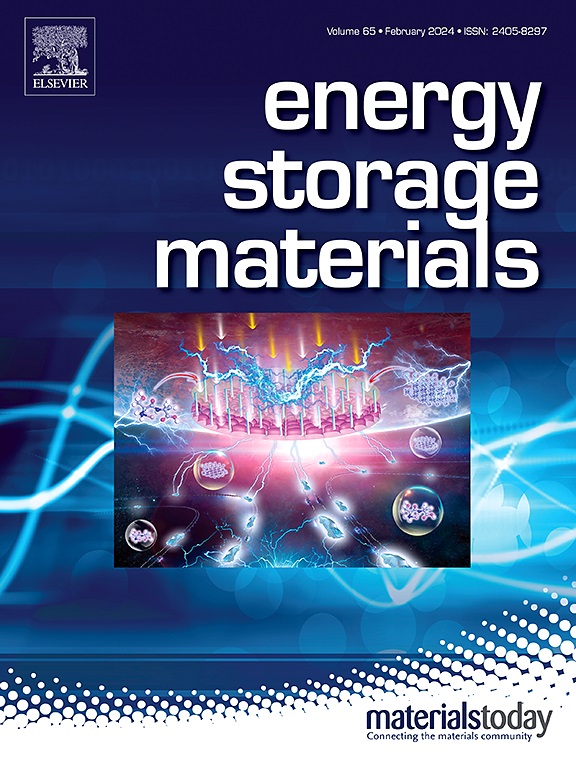沸石咪唑盐框架衍生双功能co - mn3o4异质结构阴极通过动态o空位形成和修复增强高性能锌空气电池的氧还原/释放
IF 20.2
1区 材料科学
Q1 CHEMISTRY, PHYSICAL
引用次数: 0
摘要
锌空气电池(ZABs)是一种具有广泛应用前景的电化学储能材料,但其阴极活性差,充电时的析氧反应(OER)和放电时的氧还原反应(ORR)可逆性差,限制了其性能。在此,我们报道了一种双功能的CoO-Mn3O4异质结构(CMH)阴极,该阴极由mn掺杂的沸石咪唑盐框架合成,作为解决这些挑战的方法。结合机器学习增强的密度泛函数理论模拟和18O同位素标记的operando微分电化学质谱分析显示,在ORR过程中,通过Mn位点的OH-解吸形成动态o空位(Ov),或在OER过程中,通过Mn-Mn位点的双齿氧吸附形成动态o空位(Ov),并通过OH-吸附和去质子化进行动态Ov愈合。这一动态过程降低了O*的结合能,激活了晶格氧化机制,实现了高效的OER/ORR,表现为OER创纪录的低过电位和超过2000个循环的稳定运行,ORR的扩散限制电流密度为7.1 mA·cm-2,超过了Pt/C (5.0 mA cm-2)。此外,采用CMH阴极的ZAB具有理想的开路电压(1.43 V)和802 mAh·g-1的高容量(理论容量的97.8%),可以实现创纪录的高能量密度(898 Wh·kg-1),超高峰值功率密度(394.2 mW·cm-2),以及在600次循环中可以忽略电压衰减的稳定性。本文章由计算机程序翻译,如有差异,请以英文原文为准。

Zeolitic imidazolate framework-derived bifunctional CoO-Mn3O4 heterostructure cathode enhancing oxygen reduction/evolution via dynamic O-vacancy formation and healing for high-performance Zn-air batteries
Zn-air batteries (ZABs) are promising electrochemical energy storages for many applications, yet their performance is limited by their cathode's poor activity and reversibility for oxygen evolution reaction (OER) in charge and oxygen reduction reaction (ORR) in discharge. Herein, we report a bifunctional CoO-Mn3O4 heterostructure (CMH) cathode synthesized from an Mn-doped zeolitic imidazolate framework as a solution to these challenges. Combined machine learning-augmented density functional theory simulations and operando differential electrochemical mass spectrometry with 18O isotope labeling reveal dynamic O-vacancy (Ov) formation through OH- desorption from Mn sites during ORR or bidentate oxygen adsorption at Mn-Mn sites during OER, with dynamic Ov healing through OH- adsorption and deprotonation. This dynamic process lowers O* binding energy to activate the lattice oxidation mechanism for efficient OER/ORR, exhibited by record-low overpotential and stable operation over 2000 cycles for OER and a diffusion-limited current density of 7.1 mA·cm-2 surpassing Pt/C (5.0 mA cm-2) for ORR. Moreover, the ZAB with the CMH cathode benefits from an ideal open-circuit voltage (1.43 V) and a high capacity of 802 mAh·g-1 (97.8 % of theoretical), to achieve its record-high energy density (898 Wh·kg-1), ultrahigh peak-power density (394.2 mW·cm-2), and stability with negligible voltage degradation over 600 cycles.
求助全文
通过发布文献求助,成功后即可免费获取论文全文。
去求助
来源期刊

Energy Storage Materials
Materials Science-General Materials Science
CiteScore
33.00
自引率
5.90%
发文量
652
审稿时长
27 days
期刊介绍:
Energy Storage Materials is a global interdisciplinary journal dedicated to sharing scientific and technological advancements in materials and devices for advanced energy storage and related energy conversion, such as in metal-O2 batteries. The journal features comprehensive research articles, including full papers and short communications, as well as authoritative feature articles and reviews by leading experts in the field.
Energy Storage Materials covers a wide range of topics, including the synthesis, fabrication, structure, properties, performance, and technological applications of energy storage materials. Additionally, the journal explores strategies, policies, and developments in the field of energy storage materials and devices for sustainable energy.
Published papers are selected based on their scientific and technological significance, their ability to provide valuable new knowledge, and their relevance to the international research community.
 求助内容:
求助内容: 应助结果提醒方式:
应助结果提醒方式:


